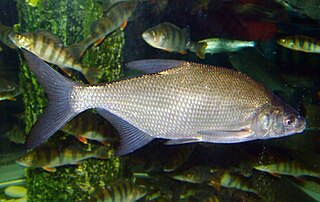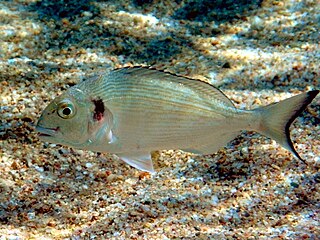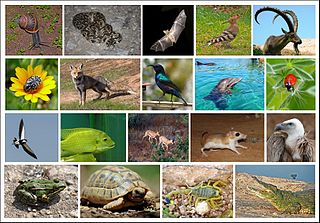
The redear sunfish, also known as the shellcracker, Georgia bream, cherry gill, chinquapin, improved bream, rouge ear sunfish and sun perch) is a freshwater fish in the family Centrarchidae and is native to the southeastern United States. Since it is a popular sport fish, it has been introduced to bodies of water all over North America. It is known for its diet of mollusks and snails.

The common bream, freshwater bream, bream, bronze bream, or carp bream, is a European species of freshwater fish in the family Cyprinidae. It is now considered to be the only species in the genus Abramis.

Teleocichla is a genus of fish in the family Cichlidae found in the Tapajós, Xingu, Tocantins and Jari River basins, which are part of the Amazon River Basin in Brazil. All species are rheophilic, and highly elongated in shape. They generally are smaller than 9 cm (3.5 in) in length, making them some of the smallest cichlids of the Americas. Only T. preta can grow larger, reaching about 12 cm (4.7 in). Since restricted to areas with fast currents, they are particularly vulnerable to the building of dams, and the Belo Monte Dam may cause the extinction of T. centisquama. Other species recognized as threatened by Brazil's Ministry of the Environment are T. cinderella, T. prionogenys and T. wajapi.

The gilt-head (sea) bream, known as Orata in antiquity and still today in Italy, is a fish of the bream family Sparidae found in the Mediterranean Sea and the eastern coastal regions of the North Atlantic Ocean. It commonly reaches about 35 centimetres (1.15 ft) in length, but may reach 70 cm (2.3 ft) and weigh up to about 7.36 kilograms (16.2 lb).

The wildlife of Israel includes the flora and fauna of Israel, which is extremely diverse due to the country's location between the temperate and the tropical zones, bordering the Mediterranean Sea in the west and the desert in the east. Species such as the Syrian brown bear and the Arabian ostrich have become extinct in Israel because of their loss of habitat. As of May 2007, 190 nature reserves have been established in Israel.

The wildlife of Jordan includes its flora and fauna and their natural habitats. Although much of the country is desert, it has several geographic regions, each with a diversity of plants and animals adapted to their own particular habitats. Fossil finds show that in Palaeolithic times, the region had Syrian brown bears, Asiatic lions, zebras, Asian elephants, and rhinoceroses, but these species are all now extinct in this region.

Acanthobrama is a genus of ray-finned fish in the family Cyprinidae found mostly in the Near East.
Acanthobrama lissneri, or the Jordan bream, is a species of freshwater fish in the family Cyprinidae. It is found in Israel and Jordan. Its natural habitats are rivers and lakes, and is now commonly found in reservoirs.
Acanthobrama terraesanctae, the Kinneret bream or Kinneret bleak, is a species of freshwater fish in the family Cyprinidae. It is known from two lakes: Lake Tiberias, Israel, and Lake Muzarib, Syria. This is a small planktivorous fish, typically about 14 cm long, occurring near surface in large schools. It is very abundant in Lake Tiberias, whereas there is little information on the other lake, which is small (0.5 km2) and can hold a small population anyway.
Acanthobrama hulensis, sometimes known as the Hula bream, was a species of ray-finned fish in the family Cyprinidae. Its natural habitats were swamps and freshwater lakes in Lake Hula in northern Israel. Acanthobrama hulensis looked much like a sardine. In Israel other members of the genus often are called "sardin" in culinary terms.

Acanthobrama telavivensis, commonly known as the Yarkon bream or Yarkon bleak, is a species of freshwater ray-finned fish of the family Cyprinidae found only in Israel, in the Yarkon River system.

Acanthopagrus australis, the yellowfin bream, also known as sea bream, surf bream, silver bream or eastern black bream, is a species of marine and freshwater fish of the porgy family, Sparidae. It is a deep-bodied fish, occasionally confused with Acanthopagrus butcheri, but is generally distinguished by its yellowish ventral and anal fins. It is a popular target for recreational fishermen due to its capacity to fight well above its weight coupled with its table quality.
Lake Amik or the Lake of Antioch was a large freshwater lake in the basin of the Orontes River in Hatay Province, Turkey; it was located north-east of the ancient city of Antioch. The lake was drained during a period from the 1940s–1970s.

The fauna of Turkey is abundant and very varied. The wildlife of Turkey includes a great diversity of plants and animals, each suited to its own particular habitat, as it a large country with many geographic and climatic regions About 1500 species of vertebrates have been recorded in the country and around 19,000 species of invertebrate. The country acts as a cross roads with links to Europe, Asia and the Near East, and many birds use the country as a staging post during migration.
Acanthobrama marmid, or the Mesopotamian bream or Tigris bream, is a species of freshwater fish in the family Cyprinidae. It is widespread and abundant in the Tigris–Euphrates river system. It lives in many kinds of lowland waters, and can also tolerate modified water bodies such as reservoirs and moderately-polluted rivers.

Acanthobrama microlepis, called the blackbrow bleak or the Caucasian bream, is a species of freshwater fish in the family Cyprinidae. It reaches a maximum size of 25 cm (9.8 in) TL. The species is found in lakes and rivers of the southwestern Caspian Sea drainage basin, including Sefīd-Rūd, Kura River and Aras River. It has also been introduced to Iraq.
Acanthobrama tricolor, or the Damascus bream, is a species of freshwater fish in the family Cyprinidae. It is endemic to Syria and the Golan Heights, and is recently only known two specimens found in the Masil al Fawwar river system in the late 1980s. It has been extirpated from the Barada river system, where it has not been seen since 1908. It is considered Critically Endangered, and may possibly be extinct, but no studies of the river systems in the Golan Heights have been conducted, and it may still survive there, but the lower Barada is now dry, and the middle portions of the river are heavily polluted.
Acanthobrama hadiyahensis , also known as the Arabian bream, is a species of freshwater cyprinid fish, which has been described from Wadi Hadiyah, Saudi Arabia.










